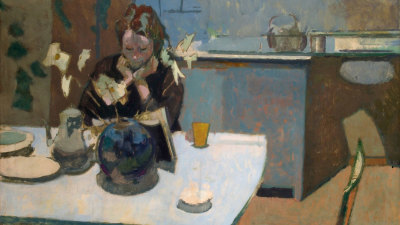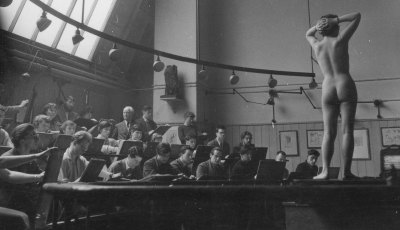In the Company of the Courtesan
In the Company of the Courtesan
By Beth Schneider
Published 7 March 2014
Beth Schneider, Head of Learning, delves between the pages of ‘In the Company of the Courtesan’ by Sarah Dunant, our RA Book Club novel of the month.
-
Here in the Learning Department, we’ve been rather inspired by Renaissance Impressions, the new exhibition of chiaroscuro woodcuts at the RA. It’s been fascinating finding out about the medium of printmaking, and how its development was linked to the rise of the printing press, as artists began to experiment with woodblock prints, etchings and engravings. Chiaroscuro prints use multiple woodblocks of the same image, each inked in different tones, to suggest the volumes of figures and forms. The technique originated in Germany and Italy, and first appeared in Venice, one of the centres of the printing world, in the early 16th century.
A printed book features prominently in the wonderful historical novel In the Company of the Courtesan by Sarah Dunant, set in Renaissance Rome and Venice. While, as we all know, it is not wise to judge a book by its cover, the current paperback edition of Dunant’s novel shows the long legs of a woman, wrapped in red fabric. Illustrated with this image, this could be a novel of any time or place. But depicted on the original paperback was Titian’s famous Venus of Urbino, a painting of a nude woman with flowing dark blonde hair, holding flowers in one hand, the other resting between her legs as she stares out at us directly and brazenly.
-

In the Company of the Courtesan

In the Company of the Courtesan
-
Titian’s image immediately takes us to the centre of the novel, a story inspired by this very painting, about a courtesan named Fiammetta Bianchini and her companion and confidant, the dwarf Bucino. Together they escape the sack of Rome in 1527 and seek refuge in the decadent streets of Venice. Throughout the novel we meet cardinals, ambassadors, writers and painters: Bucino, the narrator, describes how ‘my lady’s house became a place for pleasures of the mind as well as the body’.In the novel, Fiammetta and Bucino also come into possession of a a banned book, with erotic images drawn by Giulio Romano, engraved by Marcantonio Raimondi, and licentious sonnets by Aretino. The book was real, although none of the original engravings survive.
When the RA Learning Department explored ideas for events to support Renaissance Impressions, Dunant’s novel immediately came to mind. The exhibition includes work by Raimondi, famed for producing prints after paintings by Raphael and others, although not, of course, the images in Dunant’s novel. Also on display are prints by Ugo da Carpi, who worked in Venice with Titian, and tried to claim that he had invented the chiaroscuro technique.
Inspired by Titian’s Venus of Urbino, Sarah Dunant conjures up the rich, erotic, intellectual, political and social world of Venice in this dazzling portrait of a city and its inhabitants at one of its most potent moments in history. We’re delighted to welcome her to our next Book Club to lead our conversation about her epic novel.
RA Book Club: In the Company of the Courtesan is on 21 March 2014. Tickets cost £10.
The RA Book Club features books inspired by our exhibition programme, with the author of each novel guiding the discussion. Previous RA Book Club novels include: Evie Wyld’s ‘After the Fire, a Still Small Voice’ and ‘The Burial’ by Courtney Collins.





